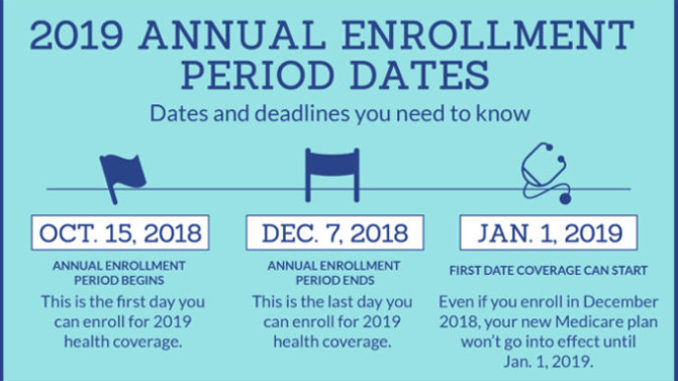
The deadline is fast approaching! The Medicare Annual Election Period, during which people with Medicare can enroll in a Medicare Advantage or Prescription Drug Plan, ends Dec. 7.
It’s important to take this time to evaluate your health care choices. Even if you’re already enrolled in a plan, your insurance company’s drug formularies, provider networks and copays may change in 2019. Plus, your health care needs – such as the doctors you visit or the medications you take – could be different than they were last year.
Here are four simple steps to help you decide which kind of Medicare coverage is best for you:
- Review your current Medicare health plan. Look at what you’ve spent on health care in the past year, including hospital expenses and prescriptions. Evaluating what you spent in 2018 will help you decide whether your current health plan meets your needs, both financially and medically.
- Know your options for Medicare coverage:
- Original Medicare (Medicare Parts A and B): Provides basic coverage for medical services and supplies in hospitals, doctors’ offices and other health care settings. Original Medicare does not include coverage for most prescriptions and includes cost-sharing in the form of deductibles and coinsurance.
- Medicare Advantage (Medicare Part C): Includes all the coverage offered under Original Medicare, and typically also includes prescription drug coverage. Medicare Advantage plans may include additional benefits as well, such as dental, hearing and vision coverage; a nurse advice line; and a fitness program. Medicare Advantage plans are offered through private insurers and are steadily gaining in popularity: The number of Americans choosing this option is expected to climb to 36 percent in 2019, up from 33 percent in 2017, according to the Centers for Medicare and Medicaid Services.
- Medicare Prescription Drug Plans (Medicare Part D): Offers coverage for prescription medications. Such a plan can be added to Original Medicare, a Medicare Supplement (Medigap) plan or to some Medicare Advantage plans (that do not include prescription drug coverage), some Medicare Cost Plans, and some Medicare Medical Savings Account (MSA) plans.
- Medicare Supplement (Medigap) Plans: Pays most costs not included under Original Medicare, such as deductibles and coinsurance. These plans do not have a set provider network, and enrollment is not limited to the Medicare Annual Election Period but they are often subject to underwriting. Medicare Supplement plans on the market today do not include prescription drug coverage.
- Comparison shop. Research a plan’s out-of-pocket costs, and its network of doctors and hospitals. Check to see if your prescriptions are on your plan’s formulary (list of covered drugs), as these can change each year. Compare plan benefits, such as dental, vision and hearing benefits; a fitness program; virtual doctors and behavioral health coverage.
- Ask an expert. You are not alone! There are resources if you have questions:
- If you prefer to learn more in person, you can attend a seminar in your area or meet with a licensed sales agent.
- If you prefer to do your research online, you can visit websites such as Medicare.gov to view and compare plans in your area.
- You can also call 1-800-MEDICARE (1-800-633-4227) (TTY: 1-877-486-2048) 24 hours a day, seven days a week for 2019 Medicare plan information to speak to someone by phone.
This is the time to make the best choice for you in the new year! Again, the Annual Election Period ends Dec. 7, 2018, so be sure to make your decision for Medicare coverage that starts Jan. 1, 2019.

Be the first to comment